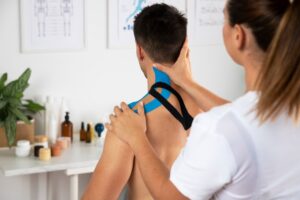The rotator cuff is a group of muscles and tendons that surround the shoulder joint, providing stability and enabling a wide range of motion. Rotator cuff conditions, including tears, tendinitis, and impingement, are common sources of shoulder pain and disability. Physical therapy is a cornerstone of both non-surgical and post-surgical treatment for these conditions.

Understanding Rotator Cuff Conditions
The rotator cuff comprises four muscles:
- Supraspinatus: Helps with lifting the arm.
- Infraspinatus: Helps with rotating the arm outward.
- Teres Minor: Also helps with rotating the arm outward.
- Subscapularis: Helps with rotating the arm inward.
Conditions affecting the rotator cuff can arise from:
- Acute Injury: A sudden tear due to a fall or lifting a heavy object.
- Degenerative Changes: Wear and tear over time, leading to tendinitis or tears.
- Impingement: Compression of the rotator cuff tendons under the acromion bone.
The Role of Physical Therapy
Physical therapy plays a vital role in:
- Pain Management: Reducing pain and inflammation.
- Restoring Range of Motion: Improving shoulder flexibility.
- Strengthening: Enhancing the strength of the rotator cuff and surrounding muscles.
- Improving Function: Helping patients return to daily activities and sports.
- Post-Surgical Rehabilitation: Guiding recovery and restoring function after surgery.
Physical Therapy Techniques
A physical therapist will design a customized treatment plan that may include:
- Manual Therapy: Hands-on techniques to mobilize the shoulder joint and surrounding soft tissues.
- Therapeutic Exercises:
Stretching: Gentle stretches to improve flexibility and range of motion.
Strengthening: Exercises to strengthen the rotator cuff muscles and scapular stabilizers.
Proprioceptive Training: Exercises to improve shoulder control and coordination.
- Modalities:
Ice and Heat Therapy: To control pain and inflammation.
Ultrasound: To promote tissue healing.
Electrical Stimulation: To reduce pain and muscle spasm.
- Patient Education: Instruction on activity modification, posture correction, and home exercise programs.
Exercises for Rotator Cuff Conditions
Here are some general examples of exercises used in physical therapy for rotator cuff conditions:
- Pendulum Exercises: Gentle swinging motions to relieve pain and improve early range of motion.
- External Rotation with Resistance Band: Strengthening the infraspinatus and teres minor.
- Scapular Squeezes: Strengthening the muscles that stabilize the shoulder blade.
- Isometric Exercises: Contracting muscles without moving the joint, useful in the early stages of healing.
- Wall Slides: Helps in improving shoulder flexion and abduction.
Rehabilitation After Rotator Cuff Surgery
Following rotator cuff surgery, physical therapy is essential for a successful recovery. The rehabilitation process typically involves several phases:
- Phase 1 (Protection Phase): Focuses on pain control and gentle range of motion exercises.
- Phase 2 (Early Strengthening Phase): Introduces light strengthening exercises.
- Phase 3 (Moderate Strengthening Phase): Progresses to more challenging strengthening exercises.
- Phase 4 (Advanced Strengthening and Return to Activity Phase): Includes sport-specific or activity-specific exercises.
Conclusion
Physical therapy is a critical component in the treatment of rotator cuff conditions. Whether you have a mild strain or are recovering from surgery, a tailored physical therapy program can help you regain shoulder function, reduce pain, and prevent future problems. If you are experiencing shoulder pain, consult a physical therapist for an accurate diagnosis and effective treatment.
Frequently Asked Questions (FAQs)
1. Can physical therapy help a rotator cuff tear?
Yes, physical therapy can be very effective in managing rotator cuff tears, especially small to medium-sized tears. It can help reduce pain, improve function, and may help avoid surgery. However, large or full-thickness tears may require surgery, followed by physical therapy.
2. How long does physical therapy for a rotator cuff injury take?
The duration of physical therapy varies depending on the severity of the injury. It may take several weeks to a few months to see significant improvement.
3. What are the signs of a rotator cuff injury?
Common signs include shoulder pain (especially at night), weakness when lifting or rotating the arm, and a dull ache deep in the shoulder.
4. Is it safe to exercise with a rotator cuff injury?
Some exercises are safe and beneficial, but it’s crucial to follow a physical therapist’s guidance. Avoid activities that cause pain or worsen your symptoms.
5. What happens if a rotator cuff tear goes untreated?
If left untreated, a rotator cuff tear can lead to chronic pain, decreased shoulder function, and the development of other shoulder problems, such as arthritis.
For more information about rotator cuff conditions and physical therapy treatment options, please visit our website at https://texasspecialtyclinic.com/.
